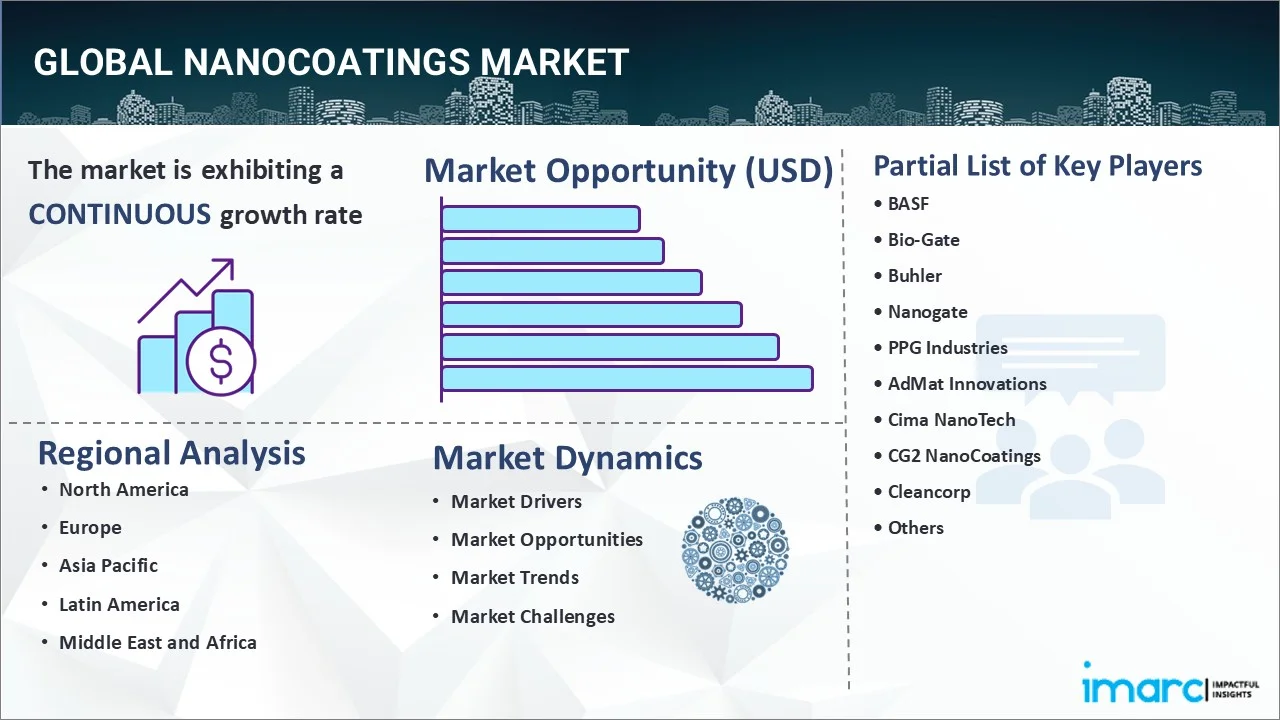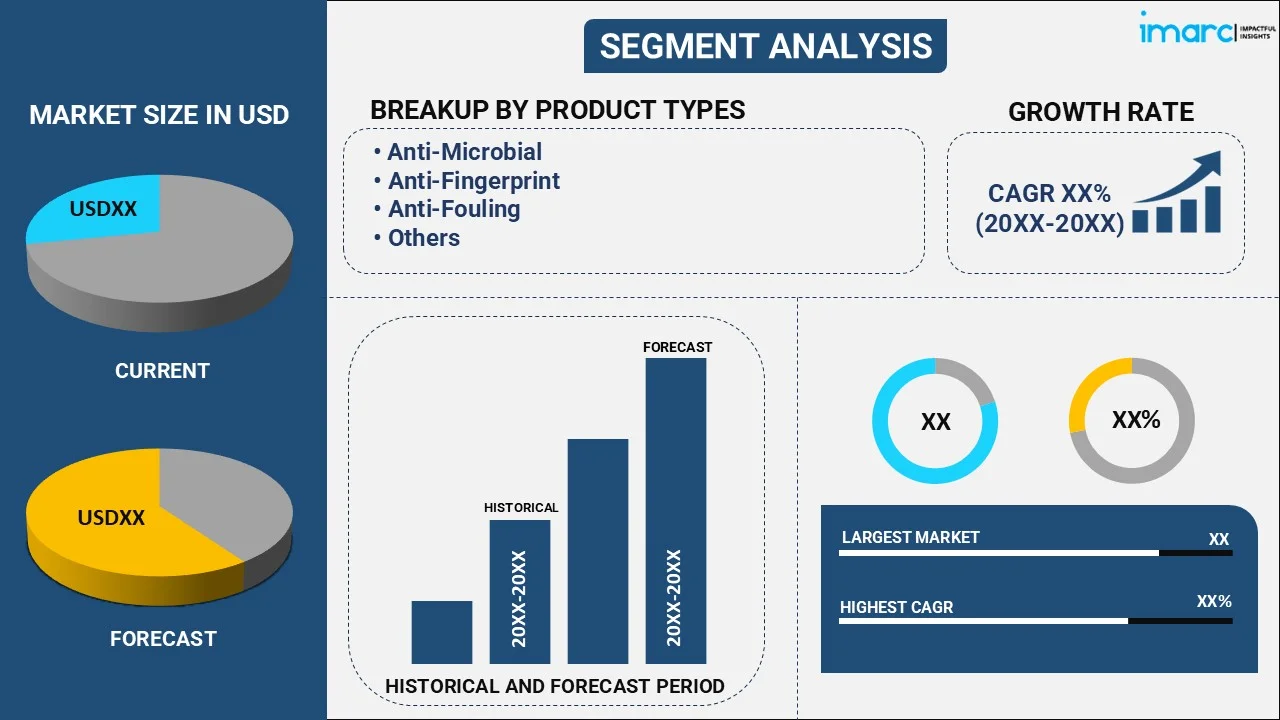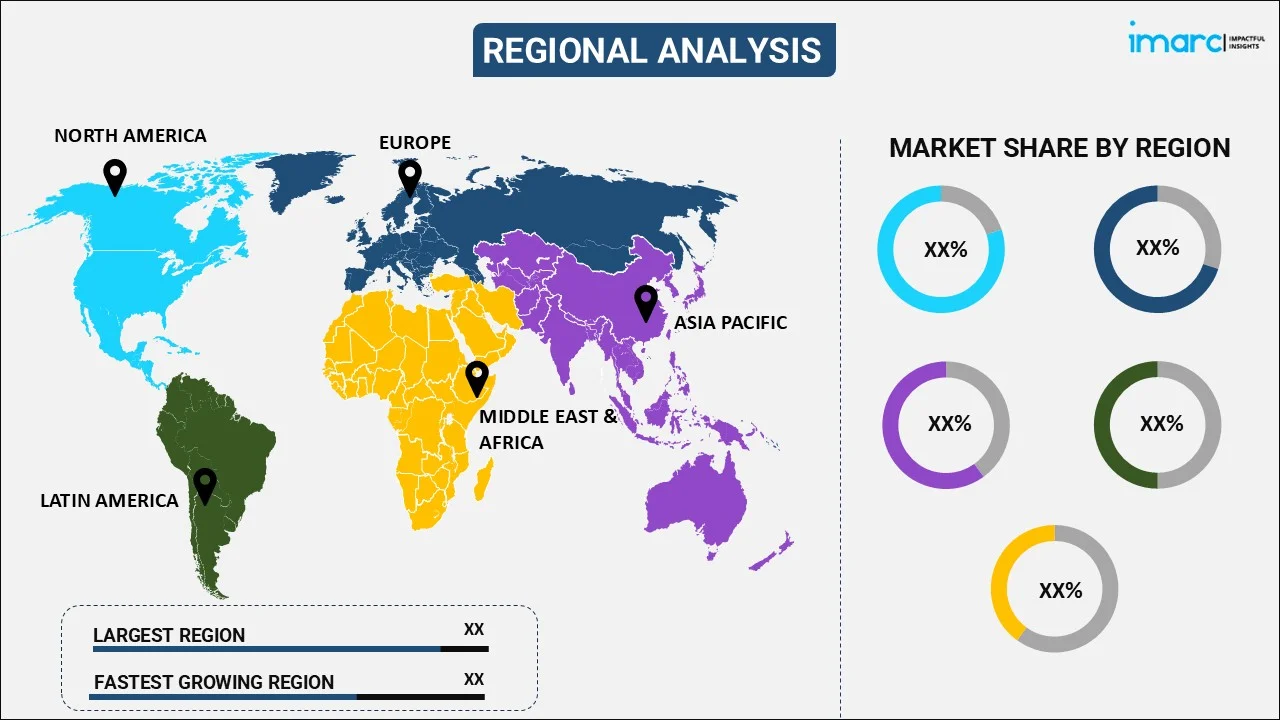
Nanocoatings Market Report by Product Type (Anti-Microbial, Anti-Fingerprint, Anti-Fouling, Easy to Clean, Self-Cleaning), End-User (Construction, Food Packaging, Healthcare, Electronics, Automotive, Marine, and Others), and Region 2025-2033
Nanocoatings Market Overview:
The global nanocoatings market size reached USD 14.2 Billion in 2024. Looking forward, IMARC Group expects the market to reach USD 58.2 Billion by 2033, exhibiting a growth rate (CAGR) of 16.09% during 2025-2033. The market is driven by the growing need to make medications soluble and bioavailable, rising focus on protecting surfaces of solar panels from dirt, scratches, and other impurities, and the thriving textile industry.
|
Report Attribute
|
Key Statistics
|
|---|---|
|
Base Year
|
2024
|
|
Forecast Years
|
2025-2033
|
|
Historical Years
|
2019-2024
|
|
Market Size in 2024
|
USD 14.2 Billion |
|
Market Forecast in 2033
|
USD 58.2 Billion |
| Market Growth Rate 2025-2033 | 16.09% |
Nanocoatings Market Analysis:
- Major Market Drivers: The rising employment of nanocoatings in the nanotechnology-based drug delivery systems, as they can lessen the negative effects associated with traditional drug delivery systems, is propelling the growth of the market.
- Key Market Trends: People are preferring solar panels with nanocoatings on their surface that reflects less light and increases the amount of light that is absorbed and turned into electricity.
- Geographical Trends: North America enjoys the leading position in the market due to the existence of sophisticated manufacturing facilities that incorporate cutting-edge technology.
- Competitive Landscape: Some of the major market players in the nanocoatings industry include BASF, Bio-Gate, Buhler, Nanogate, PPG Industries, AdMat Innovations, Cima NanoTech, CG2 NanoCoatings, Cleancorp, Ecological Coatings, Eikos, Inframat, Integran Technologies, Nanofilm, Nanomech, Nanovere Technologies, Nanophase Technologies, P2i, Surfix, and Tesla NanoCoatings, among many others.
- Challenges and Opportunities: While the market faces challenges like high production costs and complex manufacturing processes of nanocoatings, it also encounters opportunities in the growing demand for advanced coatings in industries like healthcare, automotive, and electronics.

Nanocoatings Market Growth Drivers:
Rising utilization in nanotechnology-based drug delivery systems
Drug release rates can be regulated by nanocoatings, guaranteeing a consistent and precise distribution over an extended period. This aids in keeping the drug's bloodstream concentration at the appropriate therapeutic level. Drugs are shielded from environmental elements like light, temperature, and pH via nanocoatings. Poorly soluble medications can be made more soluble and bioavailable by nanocoatings, which improves absorption and increases therapeutic efficacy. Nanocoatings serve to lessen the negative effects associated with traditional drug delivery systems by offering focused and controlled drug delivery. Because nanocoated particles can carry medications directly to tumor cells while limiting damage to healthy tissues, this is especially helpful in the treatment of cancer. As the cases of cancer is increasing around the world, there is a rise in the demand for nanotechnology-based drug delivery systems, which is propelling the growth of the market. As per an article published on the website of the World Health Organization (WHO), around 35 million new cancer cases are predicted by 2050.
Increasing demand for solar photovoltaic (PV)
Solar panels with nanocoatings on their surface can reflect less light, increasing the amount of light that is absorbed and turned into electricity. Water beading up and rolling off the surface of nanocoatings with hydrophobic or superhydrophobic qualities removes dust and debris. This guarantees maximum light absorption and aids in keeping the panels clean. The frequency and expense of human cleaning and maintenance are decreased by self-cleaning nanocoatings. Solar panels' surfaces can be shielded from dirt, scratches, and other impurities using nanocoatings. This prolongs the panel's lifespan and maintains its efficiency. UV rays, which over time can deteriorate the materials used in solar panels, can be blocked by nanocoatings, which is positively influencing the nanocoatings market size. Moreover, key players operating this market are focusing on expanding their business and increasing the number of solar PV manufacturing facilities. For instance, in 2023, Trina Solar, a global leader in smart solar products and solutions, announced that it will build more than 1 million square foot solar photovoltaic (PV) manufacturing facility in Wilmer, Texas, which will produce 5 GW of modules after completion.
Thriving textile industry
According to the IMARC Group’s report, the global textile market reached US$ 1,027.0 Billion in 2023. Textiles that have been nanocoated can acquire oleophobic and hydrophobic qualities that help them resist stains from oil, water, and other substances, which is catalyzing the nanocoatings demand. This is suitable for upholstery, outdoor gear, and daily wear. Because they are resistant to abrasion, UV light, and microbial growth, all of which can cause textiles to deteriorate over time, nanocoatings extend the life and durability of textiles. Anti-microbial nanocoatings are becoming more and more common in sportswear, activewear, and healthcare to stop the growth of bacteria, fungus, and other diseases, maintain hygiene, and lessen odors. Sports and outdoor activities are becoming more popular, which increases the need for high-performance textiles that can resist challenging environments. Nanocoatings offer improved comfort features, thermal regulation, and moisture wicking characteristics. People are also looking for apparel that blends style and utility, thereby bolstering the market growth.
Nanocoatings Market Segmentation:
IMARC Group provides an analysis of the key trends in each segment of the market, along with forecasts at the global and regional levels for 2025-2033. Our report has categorized the market based on product type and end user.
Breakup by Product Type:

- Anti-Microbial
- Anti-Fingerprint
- Anti-Fouling
- Easy to Clean
- Self-Cleaning
Anti-microbial accounts for the majority of the market share
The report has provided a detailed breakup and analysis of the market based on the product type. This includes anti-microbial, anti-fingerprint, anti-fouling, easy to clean, and self-cleaning. According to the report, anti-microbial represents the largest segment.
Equipment and surfaces in hospitals, clinics, and other healthcare institutions are focusing on reducing the chance of infection. Hospital furnishings, surgical tools, and medical devices are all frequently coated with anti-microbial agents. To improve hygiene and safety, anti-microbial nanocoatings are applied to a range of consumer goods, such as kitchen appliances, electronics, and textiles. Anti-microbial coatings can stop the spread of germs on high-touch surfaces in public transit, workplaces, schools, and other social spaces.
Breakup by End-User:
- Construction
- Food Packaging
- Healthcare
- Electronics
- Automotive
- Marine
- Others
Automotive holds the largest share of the industry
A detailed breakup and analysis of the market based on the end-user have also been provided in the report. This includes construction, food packaging, healthcare, electronics, automotive, marine, and others. According to the report, automotive accounts for the largest market share.
When it comes to items that are exposed to harsh climatic conditions, nanocoatings offer outstanding protection against rust and corrosion. By strengthening their resistance to abrasions and scratches, these coatings prolong the life of car exteriors and maintain the vehicle's finish. Vehicles with nanocoatings have a high-gloss surface that prolongs the appearance of newness and improves their visual appeal. This is a key selling feature for both new and old automobiles. The vehicle's appearance can be further improved by certain modern nanocoatings that possess self-healing qualities and enable them to autonomously fix minor scratches and dents.
Breakup by Region:

- North America
- Europe
- Asia Pacific
- Middle East and Africa
- Latin America
North America leads the market, accounting for the largest nanocoatings market share
The report has also provided a comprehensive analysis of all the major regional markets, which include North America, Europe, Asia Pacific, the Middle East and Africa, and Latin America. According to the report, North America represents the largest regional market for nanocoatings.
The automotive, healthcare, electronics, construction, and aerospace industries in North America, especially the US and Canada, rely extensively on nanocoatings for a variety of purposes. The need for high-performance nanocoatings is increased by the existence of sophisticated manufacturing facilities that incorporate cutting-edge technology. North America is making large expenditures in nanotechnology and it is a global leader in research and development (R&D) activities. This promotes ongoing innovations and the creation of fresh uses for nanocoatings. Industries are also eager to adopt new technology, such as nanocoatings, to improve the competitiveness, durability, and performance of their products. Moreover, key players are focusing on partnerships, collaborations, and acquisitions to expand their customer base worldwide. For instance, in 2023, Nanofilm Ltd. announced about the acquisition of AxynTeC Dünnschichttechnik GmbH to offer their unique solutions to the customers in Europe.
Competitive Landscape:
- The market research report has also provided a comprehensive analysis of the competitive landscape in the market. Detailed profiles of all major companies have also been provided. Some of the major market players in the nanocoatings industry include BASF, Bio-Gate, Buhler, Nanogate, PPG Industries, AdMat Innovations, Cima NanoTech, CG2 NanoCoatings, Cleancorp, Ecological Coatings, Eikos, Inframat, Integran Technologies, Nanofilm, Nanomech, Nanovere Technologies, Nanophase Technologies, P2i, Surfix, and Tesla NanoCoatings.
(Please note that this is only a partial list of the key players, and the complete list is provided in the report.)
- Key players in the nanocoatings industry are actively pursuing a range of tactics to fortify their positions in the market and spur innovations. Businesses are devoting significant resources to research and development (R&D) activities to produce sophisticated nanocoating solutions with enhanced performance attributes. Enhancing scratch resistance, antimicrobial qualities, durability, and self-cleaning capabilities are the main goals of these advancements. To increase their market reach and application areas, these companies are also diversifying their product lines and forming strategic alliances and partnerships. Collaborations with automakers, medical facilities, and electronics firms allow customized solutions to address certain sector requirements. Nanocoatings companies are also concentrating on sustainability by collaborating with various sustainability platforms to create innovative solutions that meet strict legal requirements. For instance, in 2024, PPG Industries announced a collaboration with RightShip, a digital maritime sustainability platform, to foster the development and adoption of innovative solutions for promoting a more sustainable future in the maritime industry.
Nanocoatings Market News:
- In 2024: BASF’s Coatings division and INEOS Automotive signed an agreement on a global automotive refinish body and paint development. The partners committed a long-term strategic collaboration that enables them to exceed the industry standard in vehicle body repair and paint refinish.
- In 2023: PPG Industries announced a $44 million investment to upgrade five powder coating manufacturing facilities in the US and Latin America.
Nanocoatings Market Report Scope:
| Report Features | Details |
|---|---|
| Base Year of the Analysis | 2024 |
| Historical Period | 2019-2024 |
| Forecast Period | 2025-2033 |
| Units | Billion USD |
| Scope of the Report | Exploration of Historical Trends and Nanocoatings Market Outlook, Industry Catalysts and Challenges, Segment-Wise Historical and Future Market Assessment:
|
| Product Types Covered | Anti-microbial, Anti-Fingerprint, Anti-Fouling, Easy to Clean, Self-Cleaning |
| End-Users Covered | Construction, Food Packaging, Healthcare, Electronics, Automotive, Marine, Others |
| Regions Covered | Asia Pacific, Europe, North America, Latin America, Middle East and Africa |
| Companies Covered | BASF, Bio-Gate, Buhler, Nanogate, PPG Industries, AdMat Innovations, Cima NanoTech, CG2 NanoCoatings, Cleancorp, Ecological Coatings, Eikos, Inframat, Integran Technologies, Nanofilm, Nanomech, Nanovere Technologies, Nanophase Technologies, P2i, Surfix, Tesla NanoCoatings, etc. |
| Customization Scope | 10% Free Customization |
| Post-Sale Analyst Support | 10-12 Weeks |
| Delivery Format | PDF and Excel through Email (We can also provide the editable version of the report in PPT/Word format on special request) |
Key Benefits for Stakeholders:
- IMARC’s industry report offers a comprehensive quantitative analysis of various market segments, historical and current market trends, nanocoatings market forecasts, and dynamics of the market from 2019-2033.
- The research report provides the latest information on the market drivers, challenges, and opportunities in the global market.
- The study maps the leading, as well as the fastest-growing, regional markets.
- Porter's five forces analysis assists stakeholders in assessing the impact of new entrants, competitive rivalry, supplier power, buyer power, and the threat of substitution. It helps stakeholders to analyze the level of competition within the nanocoatings industry and its attractiveness.
- The competitive landscape allows stakeholders to understand their competitive environment and provides insight into the current positions of key players in the market.
Key Questions Answered in This Report
The nanocoatings market was valued at USD 14.2 Billion in 2024.
The nanocoatings market is projected to exhibit a CAGR of 16.09% during 2025-2033, reaching a value of USD 58.2 Billion by 2033.
The increasing demand for advanced and durable coatings in industries like automotive, electronics, and healthcare, along with growing awareness of environmental sustainability, is driving the nanocoatings market. Additionally, their ability to enhance surface properties such as corrosion resistance, durability, and anti-fouling effects fuels market growth.
North America dominates the nanocoatings market due to high technological advancements, significant industrial applications, and substantial investment in research and development across various sectors like automotive and electronics.
Some of the major players in the nanocoatings market include BASF, Bio-Gate, Buhler, Nanogate, PPG Industries, AdMat Innovations, Cima NanoTech, CG2 NanoCoatings, Cleancorp, Ecological Coatings, Eikos, Inframat, Integran Technologies, Nanofilm, Nanomech, Nanovere Technologies, Nanophase Technologies, P2i, Surfix, Tesla NanoCoatings, etc.
Need more help?
- Speak to our experienced analysts for insights on the current market scenarios.
- Include additional segments and countries to customize the report as per your requirement.
- Gain an unparalleled competitive advantage in your domain by understanding how to utilize the report and positively impacting your operations and revenue.
- For further assistance, please connect with our analysts.
 Request Customization
Request Customization
 Speak to an Analyst
Speak to an Analyst
 Request Brochure
Request Brochure
 Inquire Before Buying
Inquire Before Buying




.webp)




.webp)












